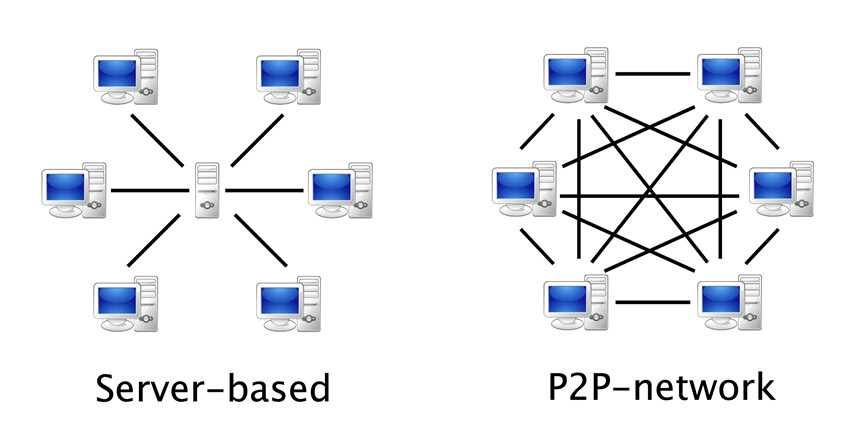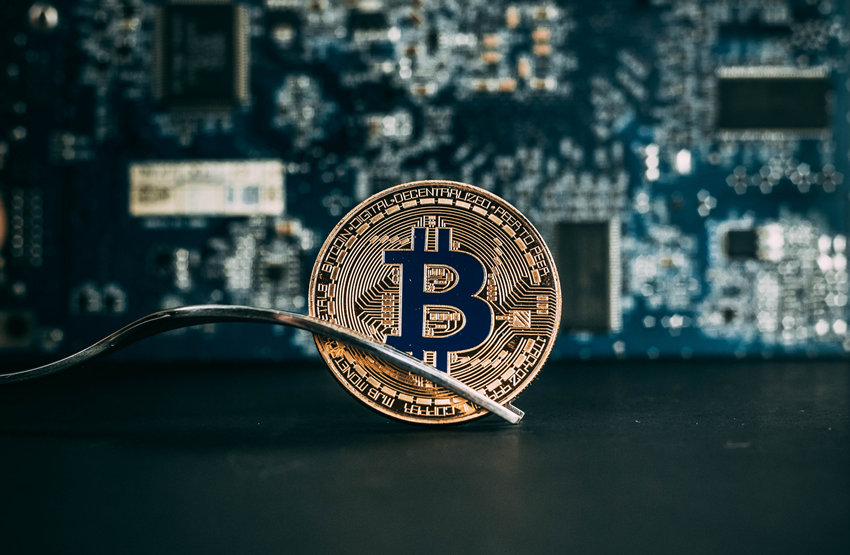This article hopes to explain the basic logic and concepts of cryptocurrcy with the example of bitcoin.
Bitcoin, first released as open-source software in 2009, is generally considered the first decentralized cryptocurrency. Let’s begin with the most basic concepts involved in Bitcoin.
P2P network
P2P network (peer-to-peer, abbreviated as P2P), also known as point-to-point network. This is a kind of Internet system without central server and exchange information between clients.
A centralized network system with a centralized server and the P2P network can be described as follows:

Unlike a centralized network with a centralized server, each client in a P2P network is both a client node and a server. An important goal of P2P networks is to enable all clients to provide resources, including bandwidth, storage space and computing power. The capacity of such a network can far exceed that of a network with a centralized server. Every time you add a client to a centralized server network, it means that the data transfer speed of all users will be reduced. However with the P2P network it’s not the case.
The robustness of P2P networks is also far greater than that of centralized server networks. Because if the centralized server goes wrong, the whole network crashes. However, if any client of P2P network has problems, the whole network still works normally.
In conclusion, Bitcoin system is a P2P network system.
Distributed computing
We know that calculating a simple mathematical problem, it is enough with one computer. But what if you had to compute a super-complex problem? This can be done using multiple computers together, and if these computers are all on the Internet, how do they link to each other? How do you pass messages and communications? How to coordinate the respective tasks and division of labor? These problems are what distributed computing systems need to solve.
Distributed system is a series of computers, which communicate and communicate with each other through the network and coordinate their behavior. Computers in the network interact with each other to achieve a common goal. A large amount of computing engineering data is divided into small “blocks”, then calculated by multiple computers, and then the computers upload operation results from respective “blocks”, finally to obtain a result.
Because the high expense of super computers, many of the world’s very complex scientific problems, is accomplished by distributed computing. Bitcoin is one of them.
What is bitcoin
The bitcoin system is essentially a distributed P2P network system. It consists of a series of computers (or other computing devices) connected to each other to form a P2P network. Each computer is equipped with a series of software, the software will form a distributed computing system, to coordinate these computer links, to communicate and coordinate for their respective tasks. Ultimately these computers interact with each other to achieve a common goal of maintaining the integrity and updating of a set of databases.
This set of database is called the Bitcoin blockchain, and blockchain technology is used in bitcoin currency. That’s the same reason we use the Internet bank as a database of bank records.
Bitcoin, in a narrow sense, is a currency that can be used to store and transmit value. In a broader sense, Bitcoin is a P2P network and a distributed computing system. The system is mostly used in cryptocurrency, of course, it has other applications.
A simplified model of bitcoin system
Imagine a village with 10 people, and one of them keeps the ledger for the village. The ledger has detailed records of the assets and cash flow of the village.
The problem is that the person who keeps the ledger can make changes to the ledger, and this person can easily tamper with the ledger.
In this scenario, one of the villager comes up with an idea of “every villiager engages in book-keeping”, i.e. decentralized book-keeping. So what happens now is: once any asset flow activity happens, all villagers keep record of this flow in their own ledgers. Every villager’s ledger is kept up-to-date and consistent.
Such a scenario which integrates P2P network and distributed computing can help understanding the decentralized nature of cryptocurrency system.
In this decentralized way, the villagers can use this system as currency to ensure integrity of transactions, hence the use of Bitcoin. Of course, Bitcoin has become quite complicated than this scenario by now, but it gives you a general idea.
Bitcoin is, in nature, a global P2P network system. The protocol in bitcoin is open source software, the software can be developed into applications used on PCs, on mobile phones, or computing devices which any user can use to access bitcoin system, and does not require any approval from a centralized authority.
Bitcoin is the first decentralized digital currency. Bitcoin’s transactions are verified by network nodes and recorded in an immutable public distributed ledger called a blockchain.
Appendix
EastShore’s series of tutorials on the basics of cryptocurrency:
- Understanding cryptocurrency: basics to get to know cryptocurency | EastShore Mining Devices
- Understanding cryptocurrency: quick glossary related to cryptocurrency | EastShore Mining Devices
- Understanding cryptocurrency: Detailed Introductions on Cryptocurrency Mining | EastShore Mining Devices


Pingback: Understanding cryptocurrency: quick glossary related to cryptocurrency | EastShore Mining Devices
Pingback: Understanding Cryptocurrency: Detailed Introductions on Cryptocurrency Mining | EastShore Mining Devices